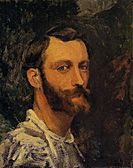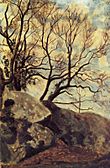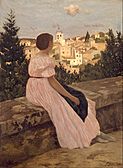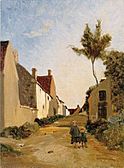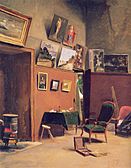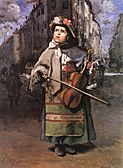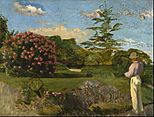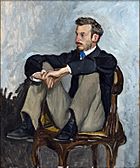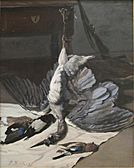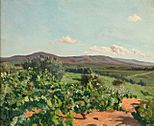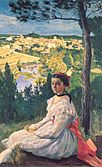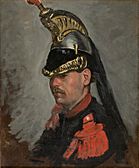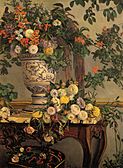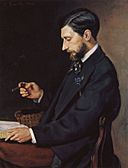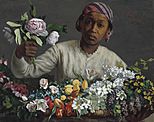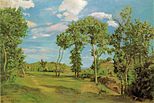Frédéric Bazille facts for kids
Quick facts for kids
Frédéric Bazille
|
|
|---|---|
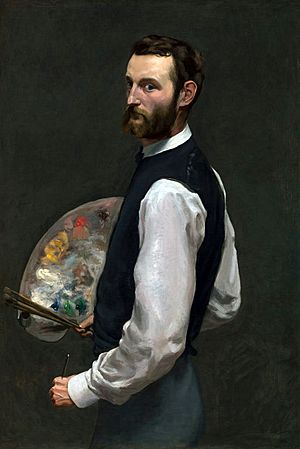
Frédéric Bazille, Self-portrait, 1865–1866, oil on canvas, Art Institute of Chicago
|
|
| Born |
Jean Frédéric Bazille
6 December 1841 |
| Died | 28 November 1870 (aged 28) Beaune-la-Rolande, France
|
| Nationality | French |
| Known for | Painting |
| Movement | Impressionism |
Frédéric Bazille was a talented French painter. He was born on December 6, 1841, and sadly died young on November 28, 1870. He was part of a famous art movement called Impressionism. Bazille often painted people in outdoor scenes. He liked to show figures within beautiful landscapes, painted outside in the open air.
Contents
Life of Frédéric Bazille
Frédéric Bazille was born in Montpellier, France. His family was wealthy and owned a wine business. He grew up on a large wine estate near Montpellier.
Early Interest in Art
Bazille became interested in painting after seeing artworks by Eugène Delacroix. His family agreed to let him study art. But they also wanted him to study medicine.
In 1859, Bazille began studying medicine. He moved to Paris in 1862 to continue his studies. In Paris, he met other artists like Pierre-Auguste Renoir and Alfred Sisley. He was very interested in the new style of painting called Impressionism. He started taking art classes in a studio run by Charles Gleyre.
Becoming a Full-Time Painter
Bazille did not pass his medical exam in 1864. After that, he decided to paint full-time. He became close friends with famous painters like Claude Monet, Alfred Sisley, and Édouard Manet.
Frédéric Bazille was a very kind and generous person. He came from a wealthy family. He often helped his artist friends who were not as rich. He would let them use space in his art studio. He also gave them art supplies.
Famous Paintings
Bazille was only 23 years old when he painted some of his most famous works. One of these is The Pink Dress from around 1864. This painting shows Bazille's cousin, Thérèse des Hours, from behind. She is looking out at a sunny landscape.
His most well-known painting is Family Reunion. He painted this between 1867 and 1868. Both The Pink Dress and Family Reunion are now in the Musée d'Orsay in Paris.
Military Service and Death
In August 1870, Frédéric Bazille joined a military group called the Zouave regiment. This was one month after the Franco-Prussian War began.
On November 28, 1870, Bazille was with his unit during the Battle of Beaune-la-Rolande. His officer was hurt, so Bazille bravely took command. He led an attack on the German position. Sadly, he was hit twice during this attack and died on the battlefield. He was only 28 years old. His father traveled to the battlefield to bring his body home. Bazille was buried in Montpellier a week later.
Main works
- La robe rose, (1864) – Musée d'Orsay, Paris
- Studio on Rue Furstenberg, (1865) – Musée Fabre, Montpellier
- Aigues-Mortes, (1867) – Musée Fabre, Montpellier
- Self-portrait, (1865) – Art Institute of Chicago
- Family Reunion, (1867) – Musée d'Orsay, Paris
- Le Pécheur à l'épervier, (1868) – Fondation Rau pour le tiers-monde, Zürich
- View of the Village, (1868) – Musée Fabre, Montpellier
- Scène d'été, (1869) – Cambridge, Harvard University
- La Toilette, (1870) – Musée Fabre, Montpellier
- L'Atelier de la rue Condamine, (1870) – Musée d'Orsay, Paris
- Paysage au bord du Lez, (1870) – The Minneapolis Institute of Arts, Minneapolis
Gallery
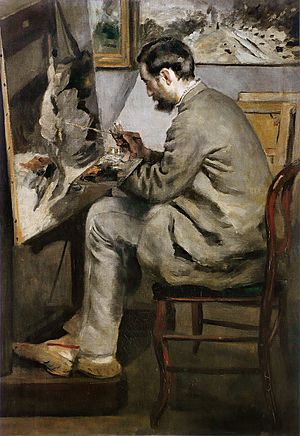
-
The Pink Dress (View of Castelnau-le-Lez, Hérault), 1864, oil on canvas, Musée d'Orsay
-
Chailly, 1865, Musée Fabre, Montpellier
-
Le Petit Jardinier (The Little Gardener), c. 1866–67, oil on canvas Museum of Fine Arts, Houston
-
Portrait of Renoir, 1867, oil on canvas, Musée d'Orsay
-
Aigues-Mortes, 1867
-
The Family Reunion, c. 1867, Musée d'Orsay
-
Portrait of Paul Verlaine, 1868, Dallas Museum of Art
-
Scène d'été, 1869, Fogg Art Museum, Cambridge, Massachusetts
-
Black Woman with Peonies, 1870, National Gallery of Art
-
Paysage au bord du Lez, 1870, oil on canvas, Minneapolis Institute of Arts
See also
 In Spanish: Frédéric Bazille para niños
In Spanish: Frédéric Bazille para niños
- A Studio at Les Batignolles


